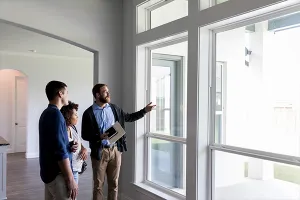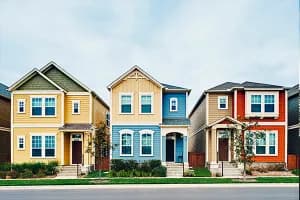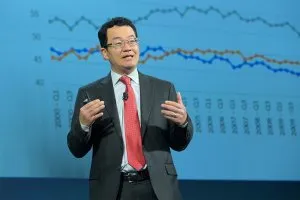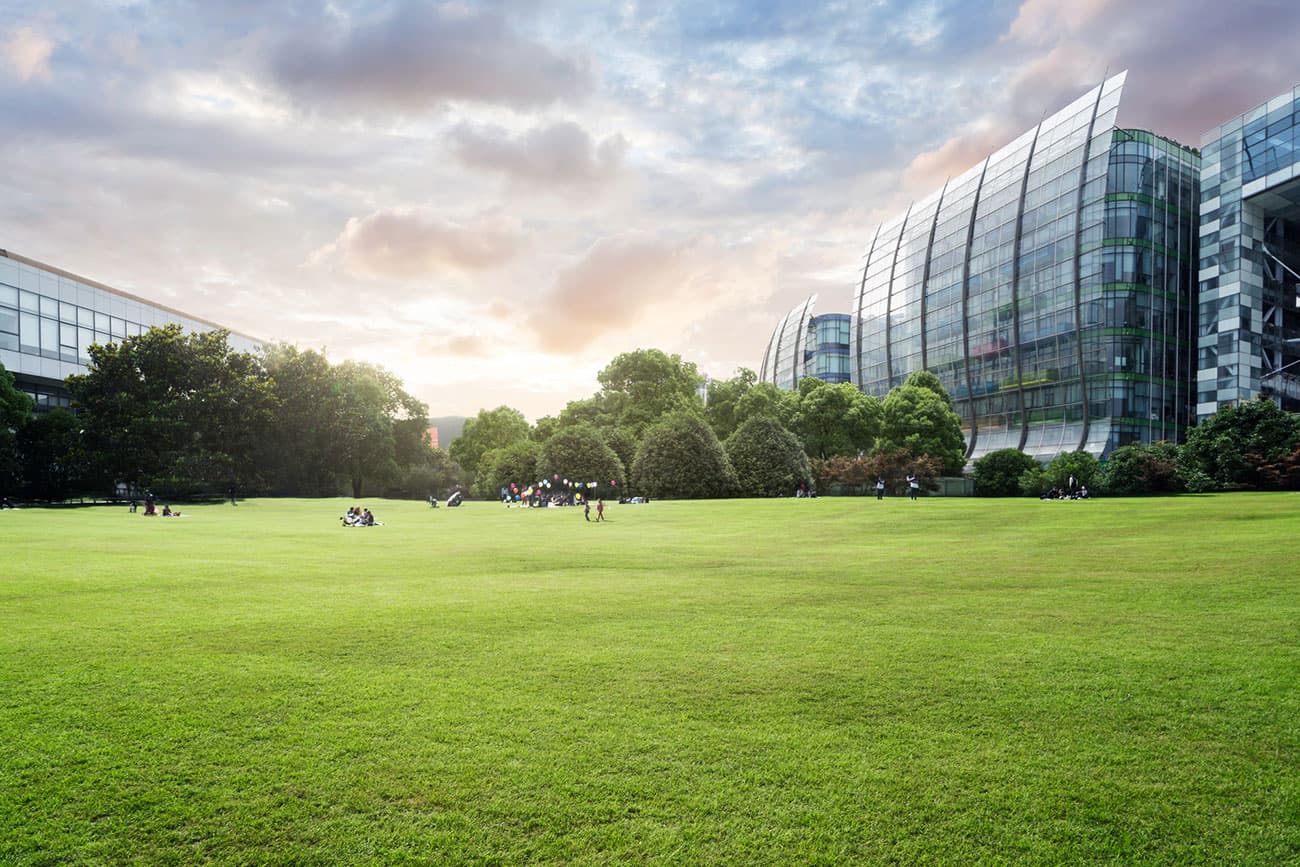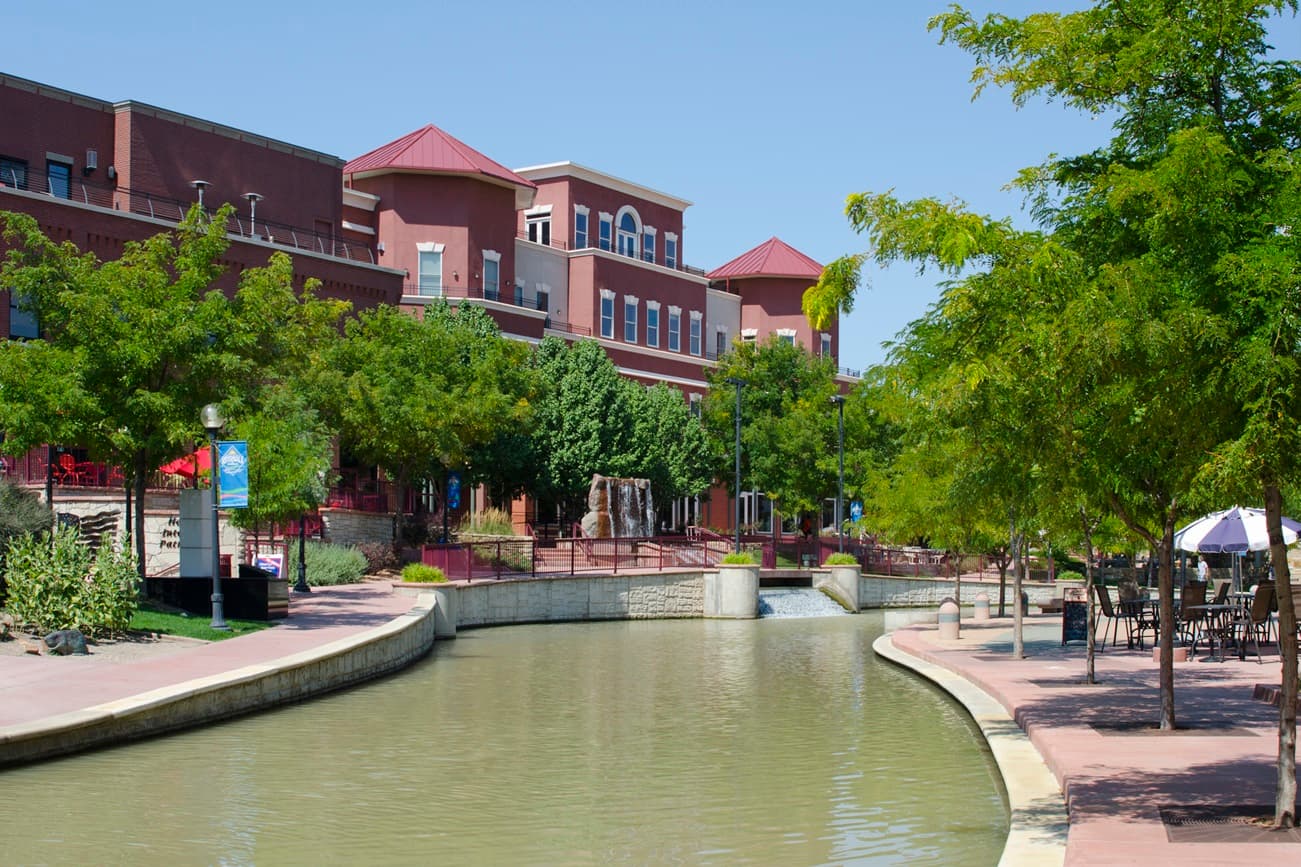Lee Clippard is playing a key role in a movement he probably never anticipated he’d join—that of creating resilience in today’s buildings and landscapes.

“The Lady Bird Johnson Wildflower Center is part of a growing group of organizations trying to figure out how to create healthy, resilient, regenerative landscapes around human development,” explains the Austin, Texas-based botanical garden’s executive director. “It’s about having our cities and communities grow responsibly, be supportive of the environment, and use fewer resources.”
Another player is Bob Harris, FAIA, LEED Fellow, and a San Antonio-based partner at Lake Flato Architects. His team is partnering with Clippard’s to build a system that helps the center recapture rainwater on a vastly more massive scale than it does today with its 30-year-old setup.
As conditions change, we know buildings need to be resilient.
“We know that the long term is changing,” states Harris. “As conditions change, we know buildings need to be resilient to withstand the negative impacts of climate change while also being able to adapt and thrive.”
The Range of Resilience
Developers, architects, landscape designers, and the clients of those professionals are studying nature and using it to their advantage. Often, they’re also restoring it to a healthier state because it makes economic sense for the projects they’re creating.
“Resiliency means a lot of things,” explains Harris. “At the very base, I feel it means designers, builders and owners are taking care during design and construction that the dollars and resources expended today will pay back and be useful over the long term.

“The American Institute of Architects has an awards program for sustainable buildings and resilient design,” he notes. “One measure is long life so that, for every material and financial resource you put in, you get the longest possible benefit. Resiliency also means a loose building. That means a building is flexible and adaptable to accommodate a variety of conditions in terms of its use or the climate outside.”
Landscape designer Robb Berg, president of Design Workshop in Denver, is another force in this movement. “We have to start thinking about planning smart landscapes,” he says. “We have studios in Texas where we deal with hurricanes, flooding and stormwater. We have a studio in Raleigh, N.C., that does a lot of work on sea-level rise and coastal mitigation. In our line of work, we have to be adaptive and adjustable to all these conditions.”
The Nature Conservancy has been advocating for this type of approach for decades. Thankfully, says Nate Woiwode, climate adaptation strategy lead for the organization’s northeast division, discussions about this issue today are easier than in the past. Ten years ago, TNC created Naturally Resilient Communities, a partnership that promoted the use of nature in community planning, often in response to a natural disaster.
“We were really focused on the need to promote investment in nature and nature-based solutions,” he explains. “Now I don’t find that people are questioning that premise as often. Today the questions are: What are the realistic options, and where’s the money going to come from? The biggest challenge is balancing the need to recover from a disaster with creating the time to make the choices for what a community might look like. When you’re able to take that time, investing in a more natural future makes the case for itself.”
Resilient buildings and landscapes can be smart financial investments.
That’s because resilient buildings and landscapes can be smart financial investments over the long term, whether it’s in terms of maintenance, resistance to weather extremes, or tamping down ever-increasing insurance costs. “It’s a calculation that’s made formally or informally,” says Harris. “What’s the value takeaway from the resources invested, and how does that pay off for the client’s needs?
“We have a project we’re working now, and in anticipation of a future need, we’re increasing structural conditions to withstand tornadoes to a higher level than currently required. As we do that, we can look at the material cost and impacts of designing to a higher level than otherwise required. In the past, I’m not sure it was considered. It was more building to the industry standard and what codes told us.”
Woiwode says communities that work with nature, particularly when they’re forced to start over because of a disaster, are not only more resilient in the long term, but they’re also places people love to live in.
“The biggest takeaway I’ve had — and I live on Long Island, so I have firsthand experience with superstorm Sandy and the recovery from that — is that when people have the opportunity to slow down and ask themselves: What’s the world I want to live in and what’s the community I want to be a part of? Investment in parks, natural coastlines, and rivers rise on the list,” he says.
“The world is less skeptical about this need,” he states. “Broadly speaking, these ideas are well accepted. It’s more about: How do we do this, how do we do this well, and how do we do this in a timely fashion so people feel safe in their homes and can see a future that feels really good and positive?”
When Design Puts Nature to Use
All these experts are on the ground creating projects and working on community-building efforts that creatively mesh development and nature.
“A project we completed a few years back is particularly interesting because it tells the story full circle from Hurricane Katrina,” recalls Harris. “The University of Southern Mississippi’s Gulf Coast Research Laboratory had a facility in Biloxi that was roughly eight feet above sea level but completely destroyed by Katrina.”

“A number of years later, after they’d gathered the money to rebuild, they chose a different site in Ocean Springs, just up the coast, that was 19 feet above sea level,” he notes. “They were going from something that was a complete loss at eight feet to something a bit higher than what future storm surges would need.
“It was a wooded site, largely left in its native state. It was a pristine example of the coastal habitat in southern Mississippi with a huge variety of wonderful native plants, from palmettos to native oaks. We consulted an ecological expert who evaluated how we could work with the site rather than change it.”
“There was one area on the site that had been occupied, and the natural systems had been disrupted enough to provide a natural site for us,” he explains. “It was also the highest ground, at 19 feet. Previous designs would have plopped a building on the site. But we had research that found that invasive species and trees weren’t doing well there. So, we wrapped a building in where the trees were the least viable and basically enclosed the highest ground for human activities.”
The team created a symbiotic relationship between the building and the forest.
The team used helical pier foundations for the building. “Imagine a large, steel corkscrew drilled 20 to 40 feet into the ground — as far as it needs to go to find its bearing strata, or the stable part of the site,” he explains. “That allowed us to get tighter in with the trees and not disrupt the root system so their canopies could stay interlocked with each other. It was a narrow footprint for the facility that allowed for uninterrupted forest. That created a symbiotic relationship between the building and the forest.
“By taking away some of the weaker trees and those with insect damage and creating a new wooded area, those trees will now buffer the winds. When they’re in that condition, they’ll withstand something like Katrina more readily. Since the project was completed, the university has been tracking the health of the ecosystem. Not only have native plant systems thrived, but the ecosystem’s diversity has increased. And not only is the building resilient, but it’s also a beautiful facility that people really want to go to. There’s a high degree of interaction between the indoors and outdoors. People think they’re in a special place.”
Today, Harris is working with Clippard to create a huge increase in the amount of rainwater the Lady Bird Wildlife Center captures. “When we opened in 1995, we had the largest rainwater-capture system in north America—and that’s saying something,” says Clippard. “At that time, we were a 42-acre botanical garden. We have 300 acres now, and we’ve probably quadrupled the number of staff. We’ve also gone from 40,000 visitors to almost 300,000 now. The pressure on our systems has grown substantially.”
“About a year ago, we started thinking about what the next 30 years looks like for us,” he explains. “We know more drought, water scarcity, extreme weather conditions, and just changing climate in general will change some of the qualities that will allow us to grow plants. We also expect we’ll continue to grow with Austin. Maybe 5 years from now, 500,000 visitors will come through That’s a lot to think about in Central Texas where water resources are scarce.
“Our rainwater capture capacity now is about 65 gallons of water, which is basically nothing. We’re starting to really think about how we can capture and store every last drop of rainwater across all facilities and even parking lots. More broadly, we’re thinking about how we can create buildings, infrastructure and facilities that can help us reduce our water use. It’s almost like carbon neutrality; in the same way, we’d have water neutrality.”
The project has challenged Harris to think about water capture in new ways. “We can collect a good amount of rainwater from rooftops, but that pales in comparison to what can be collected on the site,” he says. “How do we take an entry plaza, garden space, and hardscape and channel water to retain as much as possible in terracing as it falls but also to store it as it falls? This involves really understanding how much a role landscape can play in this process.”
Landscaping That Preserves and Regenerates
Berg says landscape design today falls into two buckets. “We’ve been talking about sustainable landscapes for decades,” he explains. “That means things like using the right amount of water for your climate zone or not using a lot of water if you live in the desert.
“The other bucket is resilience,” says Berg. “That means the landscape has the ability to resist or come back in times of stress caused by things like fire, extreme drought, and inundations of stormwater. It’s designing a landscape that can be resilient through a myriad of conditions.”
The Houston Arboretum is a project Berg has worked on for about 10 years with the goal to make the campus more resilient in the face of increased heat and less water. “It’s located within an extremely large park development, and the arboretum is right along the bayou, the drainage infrastructure for the city during large rain events,” he explains.
“The arboretum has suffered serious issues,” says Berg. “It has lost a large component of tree canopy — and an arboretum by definition should have a lot of trees. Our work starts with an investigation of the appropriate landscape before we start to talk about aesthetics and pick plants. It’s the same process for a fire-prone area.
“We have an incredible client who’s on board with a long process. Typically, landscape might take a couple of years for design and construction. But this is the story of regeneration and bringing the true, honest, authentic landscape of the arboretum to life. That takes probably decades in terms of growing trees and sustaining life.
“We started with the low-hanging fruit, which was to weed out all the invasive species. What was really fun was that we employed a team of goats, and they did a phenomenal job—they eat literally everything. The unintended consequence was that the goats’ grazing created a bit of a petting zoo and education area for children.
“Then we had to deal with frequent flooding along the bayou and designing landscaping that could fluctuate with the everchanging conditions, which was a super-challenge. We created a series of walkways that are designed to withstand floodwaters and can be easily hosed off to welcome people.
“We’re also adding landscape shelves where we’re adjusting the species based on the gradient of water. One area might have a plant that likes wet feet and can stand being in water for a period of time versus another area with something that can be submerged for a few days at a time. This approach doesn’t work with every client. But when we get the right client, we get to experiment, and we’re learning what works and doesn’t.”
Almost always, the challenges are aesthetics and money. “I’ve learned from 20-plus years in the practice that it’s not fair,” says Berg. “Architects on ribbon-cutting day get to show off their building, and it’ll look perfect. But our landscape looks like hair plugs for the first few years. This takes time because it’s a living, natural design we’re delivering. Some clients are looking for that instant gratification, so we’ll space plants closer to get that day-one impact. Those situations are challenging.”
“Also, good landscape design is front-loaded in costs,” he says. “You’re paying not for just the aesthetic but also for the science that goes behind choosing the right plants for the right place. It’s about understanding what year 1 and year 25 are going to look like.
“We explain to clients that they’re paying a little more up front, but ideally, they’re getting a far greater return in the long run. We measure the impact of what we do. We’ll have a post-completion review at years 3, 5 and 15 to see that this worked and this didn’t or that this didn’t work as well as we thought.
“That information is helpful in designing new projects. We can walk into a project meeting and suggest that, by using this approach to plants and design and by using these types of plants, we can save X percent on irrigation costs over time. We can show real savings.”
Perhaps that’s why Berg says his job has gotten easier. “I started in this profession in 2000, and I’ve seen a noticeable change in clients who come to us already pre-educated in things like native landscapes, resiliency and stormwater management,” he says. “I don’t know when that shift happened, but it definitely has happened. The idea of designing with nature as opposed to fighting nature has really taken off.”
Real Estate Professionals Lead on the Preservation of Public Lands
Who better to understand the value of nature to those who live and work nearby than real estate agents and brokers? In Colorado, real estate professionals have staked out a part in the preservation of regional public lands through Real Estate Professionals for Stewardship, a membership program in the Roaring Fork Valley.
“Real estate agents have a very direct role in helping people engage in this community in terms of finding homes,” says Kelsey Brasseur, development director of the Roaring Fork Outdoor Volunteers. “This program gives them a mechanism to support the stewardship of regional public lands.”
“The Roaring Fork Outdoor Volunteers was founded around annual trail maintenance,” says Brasseur. “We work with local, state and federal land managers to get volunteers together to go out to those trails to do things like dig drainage that prevents erosion, build rock steps, repair bridges, and cut back corridors so trails are open and safe. We also do a lot of wildfire adaptation work, which is reducing the amount of potential wildfire fuels and mitigating the effects of previous burns.”
Real Estate Professionals for Stewardship supports that effort primarily with funding. It was spearheaded by REALTORS® on the outdoor volunteer group’s board, Randy Gold and Victoria Thomas, who continue to serve as liaisons and ambassadors. Its 10-20 members provide gifts starting at $250 and reaching $5,000, with several real estate companies participating in matching programs.
As of March, the Real Estate Professionals for Stewardship 2025 campaign had raised nearly $30,000 from real estate agents and brokerages, reports Brasseur.
“Just having their personal or the company’s brand associated with conserving public lands is really powerful because of the amount of business they do in the community each year,” she says. “To have real estate professionals stand up and say, ‘We support the conservation of our public lands,’ that’s inherently valuable.”
